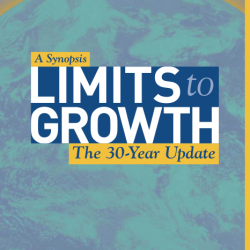

by Elizabeth Sawin
— November 7, 2005 —
Three concrete steps towards sustainability in the U.S.? That shouldn’t be a hard list to create. Certainly there are enough possible steps out there waiting for us to take them. The first that come to mind:
1. Charge the full costs of resource use — not just what it costs to catch a fish or [...]



By Donella Meadows, Jorgen Randers, and Dennis Meadows
The following piece is a short synopsis of Limits to Growth: The 30-Year Update. The full length book is available at Chelsea Green’s website.
A Synopsis: Limits to Growth: The 30-Year Update
The signs are everywhere around us:
Sea level has risen 10–20 cm since 1900. Most non-polar glaciers are retreating, and the extent and thickness [...]


by Hal Hamilton
— August 2003 —
How can sustainable agriculture gain greater traction, particularly for midrange farmers?
Although small farms, particularly those around metropolitan regions, are enjoying resurgence in recent years, the midrange of agriculture is stuck in conventional commodity production. These midrange farms are usually too big to market products directly to consumers and too small to compete in commodity markets.
In [...]


by Elizabeth Sawin
— May 1, 2003 —
Some years ago, I was part of a group that set out to create a community where we could experiment with sustainable living. One of our first steps was to write down a list of guiding principles. At the top of our list were Community and Sustainability. (The others, if you are curious, were [...]


by Hal Hamilton
— June 17, 2002 —
Dennis Avery is the leading challenger of sustainable agriculture, and he sets up “high-yield” agriculture as its opposite. Why can’t high-yield agriculture also be sustainable?
Unfortunately, Avery seems less interested in exploring the future of farming than in selling industrial agriculture. He claims that industrial methods are the best way to preserve nature and feed [...]
 By Donella Meadows, Jorgen Randers, and Dennis Meadows
The following piece is a short synopsis of Limits to Growth: The 30-Year Update. The full length book is available at Chelsea Green’s website.
A Synopsis: Limits to Growth: The 30-Year Update
The signs are everywhere around us:
Sea level has risen 10–20 cm since 1900. Most non-polar glaciers are retreating, and the extent and thickness [...]
By Donella Meadows, Jorgen Randers, and Dennis Meadows
The following piece is a short synopsis of Limits to Growth: The 30-Year Update. The full length book is available at Chelsea Green’s website.
A Synopsis: Limits to Growth: The 30-Year Update
The signs are everywhere around us:
Sea level has risen 10–20 cm since 1900. Most non-polar glaciers are retreating, and the extent and thickness [...]





